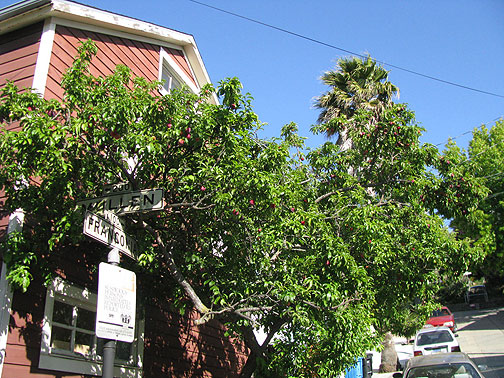
Plum tree bursting with fruit at Mullen and Franconia on the north side of Bernal Heights, June 2009.
I’m deep into researching a new book project these days, covering San Francisco history from the late sixties to the late seventies. It’s incredibly fun to be in discussion with a couple dozen great writers and historians, learning as I go how much more complicated and nuanced all these stories are than my first (rather glib) overview. It goes hand in hand with the ongoing push on the wiki FoundSF.org, which is getting almost 5,000 visitors a month already. We redesigned it a couple of weeks ago, so if you only saw it once a few months ago, have another look. And we’re going to have a much simpler system for submitting material by the end of summer. Part of the fun of that project, and part of what makes it so damn infinite, is getting turned on to new resources. Case in point: via my friends at the Bernal History Project I learned about this amazing photo collection by Charles W. Cushman at Indiana University.
A couple of great books on local history have further enriched my work. Just out is “Street Art San Francisco: Mission Muralismo” edited by Annice Jacoby (full disclosure: I have a short piece in it about Mona Caron’s Market Street Railway Mural, but in fact it only bears a passing resemblance to what I actually wrote, which was not a big deal anyway.) Jaime Cortez has a great article in this book, as do another half dozen contributors, but the best thing is having a fancy coffee table book with such fantastic reproductions that really captures the breadth and depth of the street art scene in San Francisco going back to the 1970s. The other book that transported me to a time before mine is “Harlem of the West: The San Francisco Fillmore Jazz Era” by Elizabeth Pepin and Lewis Watts. Between the amazing photos, reminiscences, and narrative text, it’s an incredible history all in one volume. Drives home the sense of loss regarding the black community in San Francisco, which of course is a story still unfolding, though the geographic focus has shifted to Bayview-Hunter’s Point from the once vibrant Fillmore.
That photo I started with highlights another theme I’m increasingly interested in, urban agriculture. In San Francisco there are a couple of efforts underway, one called SF Glean, and the other Produce to the People. They are discussing a closer working relationship on one of the lists I’ve been lurking on, but in any case, they’re each doing great work connecting hungry people, willing workers, and untended fruit trees in the city, of which there are many. I came upon that plum tree above yesterday, with a rich bounty ready to eat, and a couple of weeks ago I found this loquat tree on the south side of Bernal:
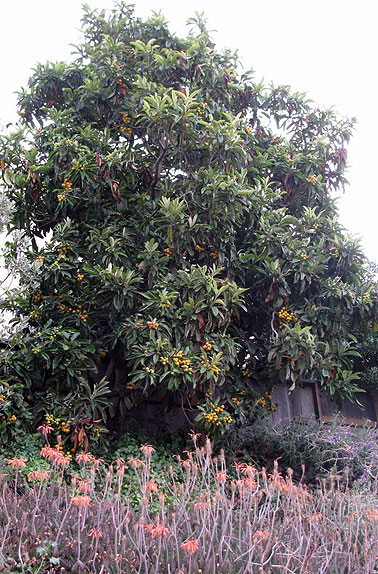
Loquats ready to harvest on Bernal, early June 2009.
Not a quarter mile further south is the increasingly well known Alemany Farm, looking pretty dang good from the hillside above:
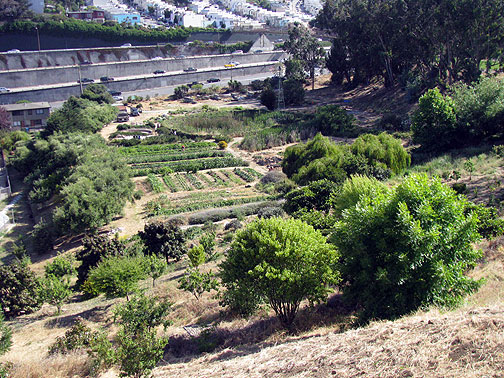
Alemany Farm with I-280 to its south, June 22, 2009. Note the orchard in foreground.
In my Nowtopian way, I can spend weeks at home, researching, reading, emailing, discussing, and then go out for a long walk on one of our glorious sunny summer afternoons and find all these great examples of ways people are already busily reinventing city life. Lately, the city itself has gotten some good work done too, from the newly greened center median on Guerrero and small plazas at 17th and Market, and Howard and Van Ness, to the jumble of new staircases descending from the southern edge of the Bernal ring road.
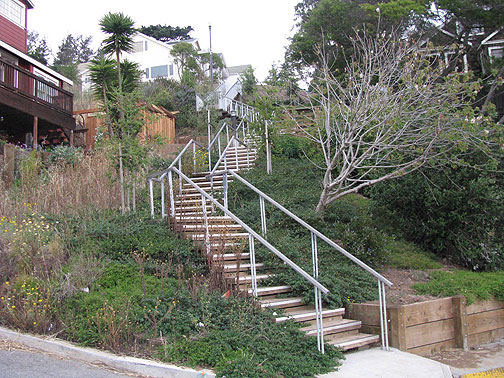
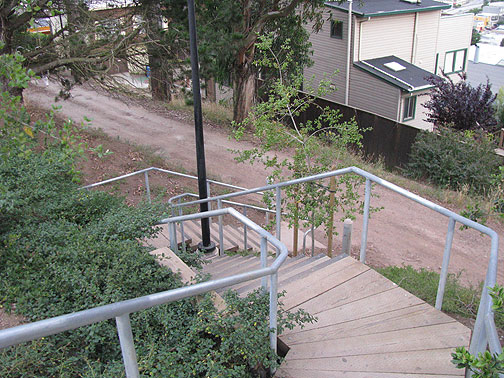
Bernal Heights, such a small area when you look at a map of the city, is one of the best walkers’ paradises in town. The new staircases join an existing network of stairs and ghost streets that make it possible to walk up and down the hill and avoid streets for long stretches of the walk.
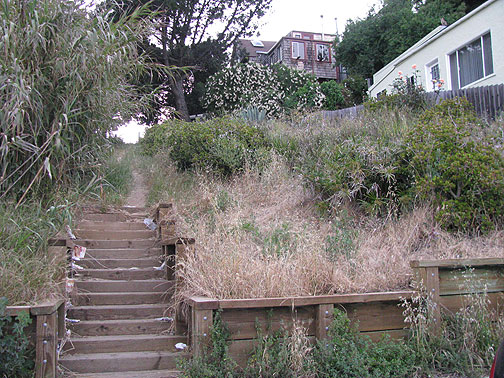
One of many "ghost streets" on Bernal Heights, this one with some old wooden steps inviting the walker to enter.
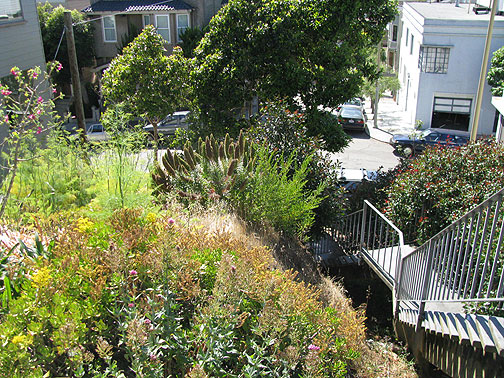
Kingston stairs on west side of Bernal, older and more established.
When you walk up and down these stairways and realize how much time and effort neighbors put in to making these places the lush, attractive gardens they are, it’s quite impressive. In some areas it’s more than just pretty flowers and plants too, they’re actual community gardens, like this one on Cortland and Prospect:
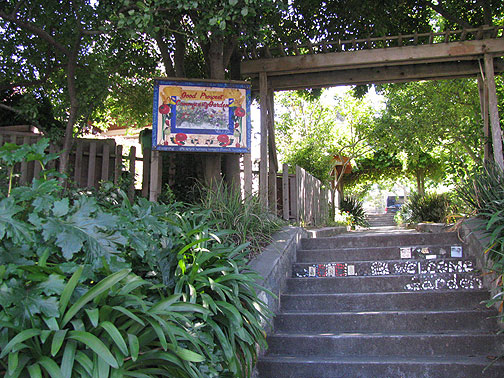
Prospect and Cortland Community Garden.
Funny to think of San Francisco as a windswept, barren, sandy and flea-ridden peninsula. These days it’s starting to look like a garden oasis, and if you spend time walking on the hills, behind Noe or Eureka Valleys, on Telegraph Hill or Russian Hill, Bernal or Potrero, you are in for a treat!
All this is to highlight the invisible WORK that’s going on all the time, that we barely notice or register as such. Since it’s not remunerated, it’s relegated to “mere hobby” instead of being seen for what it is, cutting-edge labor to reinvent urban life. Of course I’ve been ranting about this for some years now, and regular readers won’t find this surprising. But I think the cultural zeitgeist *might* be shifting towards a more interesting discussion on “work worth doing”.
In the June 22 issue of The New Yorker Kelefa Sanneh writes about some new titles, and by serendipitous coincidence, brings into the discussion a book that I thought quite important when I read it when age 17: “Zen and the Art of Motorcycle Maintenance.” I don’t recognize his account of that book’s relevance much, but do remember how much author Robert Pirsig’s obsession with dualism, and the difference between classical and romantic thinking, set me off on a whole track towards philosophy back there in 1974. Sanneh is using the more prosaic aspect of the book, the interest in motorcycle maintenance, to link it with some new titles that have just come out recently: “Shop Class as Soul Craft: An Inquiry into the Value of Work” by Matthew Crawford, and “The Pleasures and Sorrows of Work” by Alain de Botton. I caught Crawford on “Your Call” (mp3) not long ago, and even had to call in to brag about recently fixing my leaking kitchen faucet. He was on with the editor of Make Magazine, and it was a ramp-up to the Maker’s Faire that I wrote about a few weeks ago.
In this essay Sanneh usefully surveys a lot of parallel analysis out there, from Bill McKibben’s great “Deep Economy” to Michael Pollan’s food writings. As we can see, there are many ways that people are turning away from straight-up capitalist markets and beginning to redefine “need,” “desire,” “enough,” and even, hopefully, “growth.” He even brings Victorian philosopher John Ruskin into the discussion as an advocate of “freedom through toil,” albeit with a focus on the quality of the work experience rather than an endorsement of slaving away in coal mines or the hellish factories of his era.
If boring labor is a threat to one’s humanity, it stands to reason that interesting labor can be a form of redemption. The Victorian sage John Ruskin helped invent the modern cult of the craftsman: he was both an idealist and an aesthete, and he argued that miserable workers produced miserable work, and vice versa. In “The Craftsman,” [Richard] Sennett portrays Ruskin as a quirky and quixotic radical, sensitive to the intricate demands of great craftsmanship, and hopeful that the glories of Venetian architecture might help inspire workers to resist the ravages of “mechanical domination.”
..But how do you serve craftsmanship without serving the market? How can an independent artisan insure that he doesn’t become an entrepreneur” and, in time, a corporate executive? This question haunts Crawford’s book, and it helps explain why he takes pains to present himself as merely an aspiring craftsman with “execrable” skills; a professional mechanic who still feels “like an amateur.” These disclaimers are meant to assure readers that, in a society afflicted by hyper-specialization, Crawford isn’t some technical wizard; he’s just a regular guy who happens to be handy with a seal puller. The idea is that we can become him, and that he won’t become someone else” he won’t build a bigger shop, hire more mechanics, expand into Maryland and then Delaware, create a lucrative line of Shockoe Moto leather jackets, and, finally, collaborate with BMW on a gleaming series of R69S replicas. He won’t, in other words, end up like Gene Kahn, the organic-farming pioneer who appears in “The Omnivore’s Dilemma” as a vexed figure: Cascadian Farm, which he founded in 1971, has thrived and grown and joined the corporate food chain; Kahn is now the vice-president for sustainable development at General Mills.
I like Sanneh’s essay for lots of reasons, not least his erudition. But it leaves me wanting, especially wanting to be part of the conversation! This is where, perhaps, publishing Nowtopia with AK Press leaves the ideas in it out of the discussion. Maybe if it had been published by a NY publisher, Sanneh would have noticed that it addresses the same topics from a quite different, and perhaps edgier point of view? We’ll never know. Unlike Crawford, the author of Soulcraft, or Sanneh, the reviewer, I see all this work going on outside of wage-labor as crucial proving grounds, places where imaginations and skills are shared, sharpened, and focused. Sanneh lets Crawford have it by the end, having revealed that his groping for a reconfigured political landscape is just so much blather.
In this decade, the revival of traditional craftsmanship and homegrown food has generally been seen as a progressive cause, loosely aligned with environmentalism, blue-state snobbery, and all-purpose anti-corporate activism…
Crawford seems to yearn for a rethinking of left and right, as they’re now configured. Agrarianism, like environmentalism, hasn’t always been considered a progressive cause, and there’s nothing inherently liberal about artisanal cheese, or artisanal bikes” and, just as important, nothing inherently conservative about multinational corporations. Rod Dreher, a National Review contributor and the author of “Crunchy Cons,” is ardently pro-organic and ardently anti-gay marriage. Victor Davis Hanson, the author of “Fields Without Dreams: Defending the Agrarian Idea,” is also the author of “Mexifornia,” about the dangers posed by immigration. And one of the heroes of “The Omnivore’s Dilemma” describes himself as a “Christian-conservative-libertarian-environmental-lunatic farmer.” Part of the appeal of the localist-artisanal creed, for certain liberals and conservatives alike, is precisely that it’s anti-cosmopolitan, anti-corporate, anti-progress” an alternative to the creative destruction of capitalism…
Sanneh critiques Crawford (and Michael Pollan) as fundamentally connoisseurs who are more concerned with quality workmanship than quality work conditions. Their politics is a politics of consumption rather than production, which is odd when you consider that Crawford’s primary goal seems to be to reconnect millions of computer/office geeks with manual labor. And it’s in the reclaiming of our work, wresting control of our daily activities from the mindless stupidity imposed by markets and wage-labor, where something approaching liberation might emerge. Clearly Crawford doesn’t get it, nor does de Botton’s effort, which apparently gets stuck accepting a great deal of the work being done and prefers to examine the workers’ experience of it up close without questioning the larger stupidity of which it is a part. Again and again, this is the problem with our culture, an inability and unwillingness to take responsibility for what we do all day, not just from the point of view of wanting to like your job, but from a social point of view: Why work? Why do what we do? Mightn’t we do something different? Isn’t the point of all this to achieve a good life for all? Well, that’s not happening is it? So what shall we do to reinvent our daily activities to direct them towards this goal? Crawford, like so many others, is addressing the issue from too narrow a point of view, one that is sadly quite suitable for full co-optation by the Stupid World of Work he’s ostensibly beginning to critique:
With a minimum of tweaking, he could turn “Shop Class as Soulcraft” into a first-rate motivational speech for business groups nationwide. His encomium to “tangible work that is straightforwardly useful” could easily be taken as a general exhortation to excellence. In extolling “mindful labor,” he captures precisely the quality that most managers would like to reinforce in the workers they supervise. And when he writes about the importance of “seeing clearly, or unselfishly,” and “the experience of being fully engaged in what you are doing,” he sounds like one of those business consultants he despises, delivering a message that is all the more effective because it comes covered in a sweet glaze of anti-corporate rabble-rousing. Crawford wants his readers to become better, happier, more productive workers.
Sanneh concludes with the last sentence: “Who could argue with that?”… uh… me? why yes, I do!
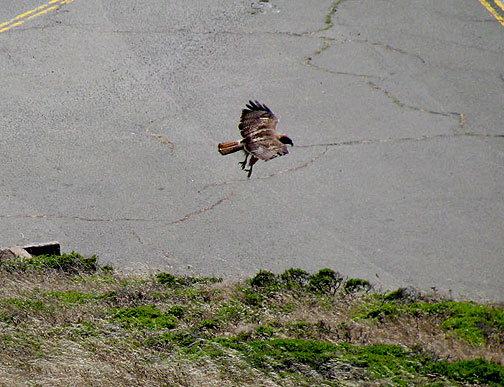
This redtailed hawk is reaching for its dinner off the south peak of Twin Peaks, June 09.
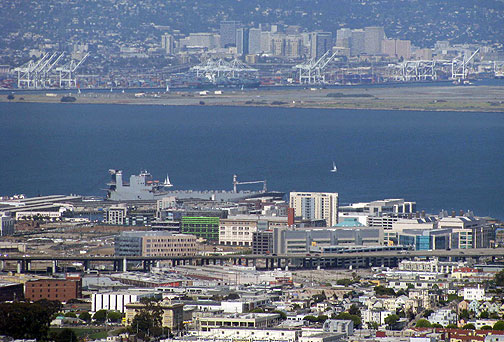
From Twin Peaks you can see two dominant industries that straddle the Bay: past the freeway the new office buildings make up UCSF Mission Bay, a biotech campus, and across the bay is the abandoned Alameda Naval Air Station with the many cranes that dominate the Port of Oakland and have been the linchpin of globalization.












Leave a Reply